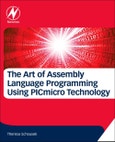Appendices are provided for completeness, especially for the advanced reader, including several Instruction Sets, ASCII character sets, Decimal-Binary-Hexadecimal conversion tables, and elaboration of ten 'Best Practices.' Two datasheets (one complete datasheet on the 10F20x series and one partial datasheet on the 16F88x series) are also provided in the Appendices to serve as an important reference, enabling the new embedded programmer to develop familiarity with the format of datasheets and the skills needed to assess the product datasheet for proper selection of a microcontroller family for any specific project.
The Art of Assembly Language Programming Using PIC® Technology is written for an audience with a broad variety of skill levels, ranging from the absolute beginner completely new to embedded control to the embedded C programmer new to assembly language.
With this book, you will be guided through the following areas:
- Symbols and terminology used by programmers and engineers in microcontroller applications
- Programming using assembly language through examples
- Familiarity with design and development practices
- Basics of mathematical knowledge in hexadecimal
- Resources for advanced mathematical functions
Approaches to locate resources
Please Note: This is an On Demand product, delivery may take up to 11 working days after payment has been received.
Table of Contents
1. Introduction 2. Microchip 8-Bit Architecture 3. Instruction Sets 4. Straight Line Code 5. Looping Code 6. Embedded Control Fundamentals 7. Fundamentals of Good Practice 8. Programming Data Structures 9. Boolean Logic and Numbering Systems 10. Mathematical Operations








